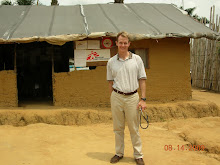

Photo: Above, local worker Soki with Doug; Below: portrait of hunger
28 August 2009
When you're in primary care you don't really think about death. Sure, it's there. I see people with malaria every day and they look awful. You know that if you treat enough people, even with seemingly minor problems, some of them aren't going to make it. For the most part, that happens outside of your direct vision. The only people you see in the clinic are alive. If they look bad you send them to the hospital and they disappear.
Remember the little girl I wrote about last week? The one from Mungele who had encephalitis and a seizure? The one who was lucky to have a pediatric neurologist around? She died. No one can tell me much. She was admitted to Intensive Care and died two days later. She looked sick but not that sick.
Remember the little girl I wrote about last week? The one from Mungele who had encephalitis and a seizure? The one who was lucky to have a pediatric neurologist around? She died. No one can tell me much. She was admitted to Intensive Care and died two days later. She looked sick but not that sick.
Yesterday I had a typical Mungele day. It was a beautiful drive out and I saw patients with the consultants all day. I even taught my first formal class in French, so was feeling pretty good. About 10 minutes before we were to head back to Lubutu, an 8 month old boy arrived. He was breathing 60 times per minute and had a little "tugging" below his ribs. But he was breastfeeding moderately well and comfortable, despite his high breathing rate. His malaria test was negative and his lung examination sounded awful. Easy enough. It's pneumonia, of course. He got a shot of antibiotics and a ride to the hospital to stay a few days. It crossed my mind to call an ambulance, but that would have taken longer.
So we packed the baby and his mother up in the car for the one hour trip. We had a driver who insisted on obeying the MSF speed rules, which are crazy-slow, so the trip was looking like it would take twice that long. We slowed to almost a halt for each group of goats or pigs or chickens, which are plentiful on the roads here.
Fifteen minutes after departure, the baby intermittently started sighing with expiration. That's a bad sign and means that breathing is getting labored. Great. I was still calm as I thought perhaps the injection of antibiotics hadn't yet been absorbed. The sighs were now coming with every expiration and I was starting to sweat. Shortly thereafter, the child's mother opened the window, leaned out, and barfed at 35 miles per hour. She's never ridden in a car before. Great. The kid now began grunting with every single exhalation. With pneumonia, grunting is what patients do right before things go rapidly downhill. As if they weren't going downhill fast enough!
As the grunts get louder, I kept waiting for each one, to let me know the child was still breathing. At this point, I was scared that the grunts and the breathing were both going to soon stop. I was in the middle of nowhere with little more than a first aid kit in the back seat.
I told the driver to speed up, and he seemed relieved to be given permission to do so. Two minutes later, the mother started yelling. The driver put on the brakes and I was about to break I was so tense. Rather than show me her dead child, the mother handed me the still breathing baby and continued to barf. The sight of a vomiting woman was never so welcome. The remainder of the trip was divided into periods of incredible speed and slamming on the brakes for the mother to get out and do her thing .
After this mid-day adventure, I was exhausted. I went back to Couvent and chatted with Gerome, the new big boss over everyone. I explained how vulnerable and exposed I felt in the truck with this very sick child. The only other alternative would have been to radio and ambulance, which would have taken even longer. So had I done the right thing by just bringing the kid with me?
Gerome thought I had. This led to a conversation about the Congolese view of death. He said that here each person is mourned and their death is regretted. But to many Congolese, the performance CPR and rescue breathing are not appropriate. There is an acceptance that for each of us there is a time for death. This should not be fought.
That got me thinking about all the brain injured children I see when working in the US. Every year I take care of children who drown. Well, they don't actually drown, which means they die from submersion. They nearly drown which means they don't die. An ambulance is summoned, the kid's heart isn't beating, and someone does CPR for 45 minutes. The ambulance shocks the kid a few times and gives him powerful drugs to restart his yet unbeating heart. But then someone feels a pulse. The child gets admitted to the pediatric intensive care unit. If he doesn't die (which he usually does) he ends up profoundly brain injured: unable to communicate, blind, and without any evidence of perceiving his surroundings. With children submerged in warm water who have no pulse when pulled out, the outcome is universally bad.
What if the parents of these unfortunate near drowned children took the Congolese view and accepted that the time for their child's death had come? Or do the Congolese hold this fatalistic view only because they have no experience with a Western medical system that can occasionally work miracles?
It's something to think about after a wild ride home.

No comments:
Post a Comment